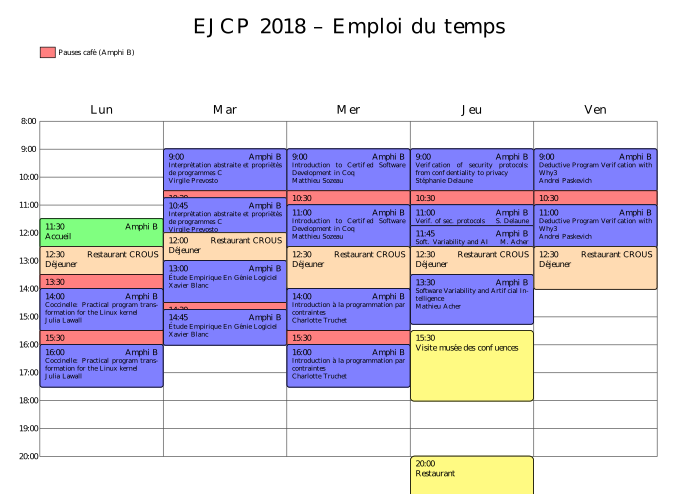|
|
|
ProgrammePlanning
Titres et descriptifs des cours Les transparents sont disponibles sur la page Supports de cours Lundi 25 juin après-midi Julia Lawall Coccinelle: Practical program transformation for the Linux kernel
Mardi 26 juin matin Virgile Prevosto: Interprétation abstraite et propriétés de programmes C
L'interprétation abstraite est une technique d'analyse de programmes introduite par Patrick et Radhia Cousot en 1977. Elle se place dans le cadre général des analyses flot de données, où l'on propage des informations le long des arêtes du graphe de flot de contrôle d'un programme, jusqu'à atteindre un point fixe, où il n'est plus possible d'ajouter de l'information à celle déjà associée à chacun des nœuds du graphe par les opérations précédentes.
Mardi 26 juin après-midi Xavier Blanc: Etude Empirique En Génie Logiciel – Application sur GitHub et Alexa
La recherche en génie logiciel vise essentiellement à optimiser la production et la maintenance logicielle. Dans un tel contexte, les études empiriques permettent de vérifier la plus-value d’approches proposées. Le principe général est de définir une hypothèse de plus-value et de la confronter à des mesures statistiques réalisées sur des projets existants. Ce cours présentera les différentes méthodes employées pour réaliser des études empiriques. Il illustrera ces méthodes en montrant les résultats obtenus ces dernières années. Enfin, une application sera présentée en prenant comme cible d’observation les projets open source dans GitHub ou les applications web populaires listées par Alexa.
Mercredi 27 juin matin Matthieu Sozeau: Introduction to Certified Software Development in Coq
This lecture will be an introduction to the Coq proof assistant and its use for the verification of programs and proofs (actually, they're the same thing!). The Coq system is based on Type Theory, which acts as a kind of formal logic and is at the same time a purely functional programming language in its own right (this link is the so-called Curry-Howard isomorphism). As such, Coq is a general purpose theorem prover that can be used to formalize mathematical proofs, including proofs about the semantics of programming languages, or proofs about computer software and systems. For example, semantic-based tools on programming languages like type checkers, compilers or static analysers can be implemented in the programming language of Coq and verified in the same language, with a high degree of confidence. We will give an informal overview of the logic and the computational programming language and its applications, focusing in particular on what this isomorphism means in practice. Of course, interactive theorem proving is a non-trivial activity, as the user and the program interact to build proofs of theorems well outside the reach of automated deduction. I will give a glimpse of how this happens in practice and why it can become a somewhat addictive game.
Mercredi 27 juin après-midi Charlotte Truchet: Introduction à la programmation par contraintes
La programmation par contraintes s’attache à résoudre des problèmes fortement combinatoires, exprimés à l’aide de relations logiques (les contraintes), portant sur des variables dans des domaines fixés, souvent finis. Chaque type de contraintes est dotée d’un algorithme de propagation, qui élague autant que possible les domaines des variable sans perdre de solutions. Les solveurs appliquent ces propagateurs tant que c’est possible, puis effectuent des choix (affectation d’une valeur à une variable, réduction d’un domaine) et itèrent le processus. On sait aujourd’hui résoudre des familles de contraintes assez larges (cardinalité, graphes, mots, géométrie…). Dans ce cours, je présenterai les notions principales du domaine (contraintes, domaines, consistance, propagation, heuristiques) puis j’introduirai un format générique pour représenter les domaines et les consistances, basé sur la notion de domaine abstrait telle que définie en interprétation abstraite, ainsi qu’une méthode de résolution générique sur ces nouveaux domaines. On détaillera l’exemple du domaine des octogones.
Jeudi 28 juin matin Stéphanie Delaune: Verification of security protocols: from confidentiality to privacy
Security protocols are widely used today to secure transactions that take place through public channels like the Internet. Typical functionalities are the transfer of a credit card number or the authentication of a user on a system. Because of their increasing ubiquity in many important applications (e.g. electronic commerce, smartphone, government-issued ID . . . ), a very important research challenge consists in developing methods and verification tools to increase our trust on security protocols, and so on the applications that rely on them.
Formal methods offer symbolic models to carefully analyse security protocols, together with a set of proof techniques and efficient tools such as ProVerif. These methods build on techniques from model-checking, automated reasoning and concurrency theory. We will explain how security protocols as well as the security properties they are supposed to achieve are formalised in symbolic models. Then, we will describe and discuss some techniques to automatically verify different kinds of security properties
Jeudi 28 juin après-midi Mathieu Acher: Software Variability and Artificial Intelligence
Most modern software systems are subject to variation or come in many variants. Web browsers like Firefox or Chrome are available on different operating systems, in different languages, while users can configure 2000+ preferences or install numerous 3rd parties extensions (or plugins). Web servers like Apache, operating systems like the Linux kernel, or a video encoder like x264 are other examples of software systems that are highly configurable at compile-time or at run-time for delivering the expected functionality andmeeting the various desires of users.
Variability ("the ability of a software system or artifact to be efficiently extended, changed,customized or configured for use in a particular context") is therefore a crucial property of software systems. Organizations capable of mastering variability can deliver high-quality variants (or products) in a short amount of time and thus attract numerous customers, new use-cases or usage contexts. A hard problem for end-users or software developers is to master the combinatorial explosion induced by variability: Hundreds of configuration options can be combined, each potentially with distinct functionality and effects on execution time, memory footprint, quality of the result, etc. The first part of this course will introduce variability-intensive systems, their applications and challenges, in various software contexts. We will use intuitive examples (like a generator of LaTeX paper variants) and real-world systems (like the Linux kernel).
A second objective of this course is to show the relevance of ArtificialIntelligence (AI) techniques for exploring and taming such enormous variability spaces. In particular, we will introduce how (1) satisfiability and constraint programming solvers can be used to properly model and reason about variability; (2) how machine learning can be used to discover constraints and predict the variability behavior of configurable systems or software product lines.
Vendredi 29 juin matin Andrei Paskevich Deductive Program Verification with Why3
This lecture is an introduction to deductive program verification and a tutorial on the Why3 tool. Why3 provides a programming language with specification annotations, type polymorphism, mutable data types, algebraic data types, pattern matching, and exceptions. It allows us to verify annotated programs using automated and interactive theorem provers like Alt-Ergo, CVC4, Z3, Coq, and many others. This lecture introduces elementary concepts and techniques of program verification: pre- and postconditions, loop invariants, ghost code, termination proofs, modeling of data structures, etc.
|



